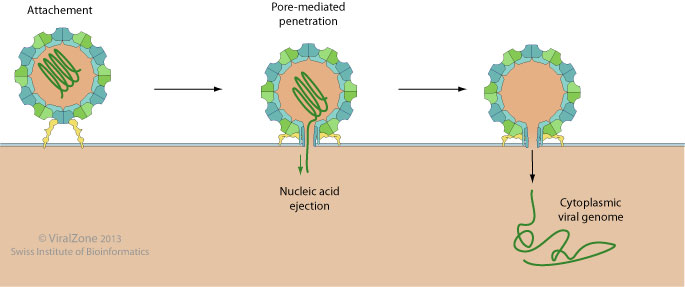Pore-mediated penetration of viral genome into host cell (kw:KW-1172)

Some non-enveloped viruses inject their genome into the host cytoplasm through creation of a pore in the host membrane. This is mediated by a viral pore-forming peptide associated with the viral capsid.
The icosahedric capsid of picornaviridae is able to create a pore either at plasma or endosomal membrane to inject their genomic RNA.
Papillomaviridae and polyomaviridae seem to enter the endoplasmic reticulum where their icosahedric capsid is disassembled, releasing pore forming proteins that induce injection of genomic DNA into cell cytoplasm.
Prokaryotic viruses such as caudovirales eject their genome into the host cytoplasm through a complex ejection apparatus. This mechanism often involves pore formation in the host membrane(s).
Matching UniProtKB/Swiss-Prot entries
(all links/actions below point to uniprot.org website)53 entries grouped by protein
4 entries
Tail knob protein gp9 (Distal tube protein) (Gene product 9) (gp9) (Protein p9)
3 entries
Tail needle protein gp26 (Head completion protein) (Packaged DNA stabilization protein) (Tail accessory factor gp26)
44 entries
Genome polyprotein
1 entry
Spike protein (Baseplate assembly protein gpV) (Gene V protein) (GpV)
1 entry
